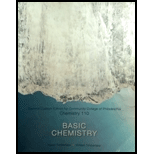
Concept explainers
(a)
Interpretation:
The group number and name of the group that contains potassium should be identified.
Concept Introduction:
In the modern periodic table, the vertical columns are known as groups and the horizontal rows are known as periods. The group of an element is determined by the number of its valence electrons and the period of an element is based on the principal quantum number of the valence shell of the element.
(a)
Answer to Problem 4.47FU
The group number is 1 and the name is alkali metals group that contains potassium.
Explanation of Solution
The group number of an element is determined by the number of its valence electrons.
The electron configuration of K (potassium) is
Potassium contains 1 electron in the valence shell. For this reason, the group number of potassium is 1.
The name of group 1 of the periodic table is alkali metals group.
(b)
Interpretation:
Whether potassium is a metal, a nonmetal, or a metalloid should be determined.
Concept Introduction:
Elements that easily lose electron(s) due to which they conduct electricity are said to be metals. Metals are shiny, ductile, and malleable and conduct heat.
(b)
Answer to Problem 4.47FU
Potassium is a metal.
Explanation of Solution
The electron configuration of K (potassium) is
Potassium readily loses valence electron (4s1) and attains stability due to easy loss of electron potassium is a metal also it is a good conductor of heat and electricity, shiny, malleable and ductile.
(c)
Interpretation:
The number of protons in a potassium atom should be determined.
Concept Introduction:
The
(c)
Answer to Problem 4.47FU
There are 19 protons in an atom of potassium.
Explanation of Solution
The atomic number of potassium is 19. This means, one atom of potassium contains 19 protons in its nucleus. For this reason, there are 19 protons in an atom of potassium.
(d)
Interpretation:
The most prevalent isotope of potassium should be identified.
Concept Introduction:
Most of the elements have two or more than two isotopes. Isotopes are the atoms that have different mass number for an element which is due to presence of different number of neutrons in their nuclei. The relative abundance of isotopes varies in nature.
(d)
Answer to Problem 4.47FU
The most prevalent isotope of potassium is
Explanation of Solution
The percent abundance of the isotope
(e)
Interpretation:
The atomic mass of potassium should be calculated from the naturally occurring isotopes and their abundance by using the weighted average mass method.
Concept Introduction:
Most of the elements have two or more than two isotopes. Isotopes are the atoms that have different mass number for an element which is due to presence of different number of neutrons in their nuclei. The relative abundance of isotopes varies in nature. For this reason, the atomic mass of an element is calculated by multiplying the mass of each isotope by its percentage abundance value and then adding all those values for all
(e)
Answer to Problem 4.47FU
The atomic mass of potassium is 39.09 amu.
Explanation of Solution
The percent abundance values and mass for each isotope of potassium are as follows:
Therefore, the atomic mass of potassium
Therefore, the atomic mass of potassium is 39.09 amu.
Want to see more full solutions like this?
Chapter 4 Solutions
BASIC CHEMISTRY >CUSTOM<
 ChemistryChemistryISBN:9781305957404Author:Steven S. Zumdahl, Susan A. Zumdahl, Donald J. DeCostePublisher:Cengage Learning
ChemistryChemistryISBN:9781305957404Author:Steven S. Zumdahl, Susan A. Zumdahl, Donald J. DeCostePublisher:Cengage Learning ChemistryChemistryISBN:9781259911156Author:Raymond Chang Dr., Jason Overby ProfessorPublisher:McGraw-Hill Education
ChemistryChemistryISBN:9781259911156Author:Raymond Chang Dr., Jason Overby ProfessorPublisher:McGraw-Hill Education Principles of Instrumental AnalysisChemistryISBN:9781305577213Author:Douglas A. Skoog, F. James Holler, Stanley R. CrouchPublisher:Cengage Learning
Principles of Instrumental AnalysisChemistryISBN:9781305577213Author:Douglas A. Skoog, F. James Holler, Stanley R. CrouchPublisher:Cengage Learning Organic ChemistryChemistryISBN:9780078021558Author:Janice Gorzynski Smith Dr.Publisher:McGraw-Hill Education
Organic ChemistryChemistryISBN:9780078021558Author:Janice Gorzynski Smith Dr.Publisher:McGraw-Hill Education Chemistry: Principles and ReactionsChemistryISBN:9781305079373Author:William L. Masterton, Cecile N. HurleyPublisher:Cengage Learning
Chemistry: Principles and ReactionsChemistryISBN:9781305079373Author:William L. Masterton, Cecile N. HurleyPublisher:Cengage Learning Elementary Principles of Chemical Processes, Bind...ChemistryISBN:9781118431221Author:Richard M. Felder, Ronald W. Rousseau, Lisa G. BullardPublisher:WILEY
Elementary Principles of Chemical Processes, Bind...ChemistryISBN:9781118431221Author:Richard M. Felder, Ronald W. Rousseau, Lisa G. BullardPublisher:WILEY





